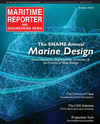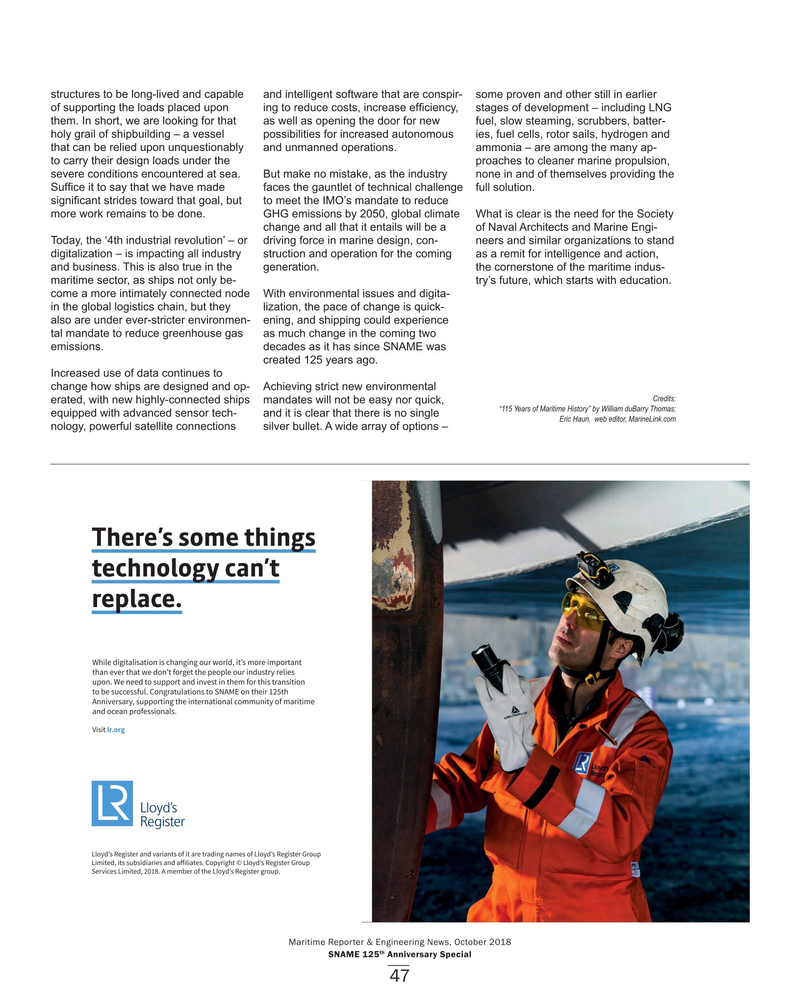
Page 47: of Maritime Reporter Magazine (October 2018)
Marine Design Annual
Read this page in Pdf, Flash or Html5 edition of October 2018 Maritime Reporter Magazine
structures to be long-lived and capable and intelligent software that are conspir- some proven and other still in earlier of supporting the loads placed upon ing to reduce costs, increase ef? ciency, stages of development – including LNG them. In short, we are looking for that as well as opening the door for new fuel, slow steaming, scrubbers, batter- holy grail of shipbuilding – a vessel possibilities for increased autonomous ies, fuel cells, rotor sails, hydrogen and that can be relied upon unquestionably and unmanned operations. ammonia – are among the many ap- to carry their design loads under the proaches to cleaner marine propulsion, severe conditions encountered at sea. But make no mistake, as the industry none in and of themselves providing the
Suf? ce it to say that we have made faces the gauntlet of technical challenge full solution.
signi? cant strides toward that goal, but to meet the IMO’s mandate to reduce more work remains to be done. GHG emissions by 2050, global climate What is clear is the need for the Society change and all that it entails will be a of Naval Architects and Marine Engi-
Today, the ‘4th industrial revolution’ – or driving force in marine design, con- neers and similar organizations to stand digitalization – is impacting all industry struction and operation for the coming as a remit for intelligence and action, and business. This is also true in the generation. the cornerstone of the maritime indus- maritime sector, as ships not only be- try’s future, which starts with education.
come a more intimately connected node With environmental issues and digita- in the global logistics chain, but they lization, the pace of change is quick- also are under ever-stricter environmen- ening, and shipping could experience tal mandate to reduce greenhouse gas as much change in the coming two emissions. decades as it has since SNAME was created 125 years ago.
Increased use of data continues to change how ships are designed and op- Achieving strict new environmental
Credits: erated, with new highly-connected ships mandates will not be easy nor quick, “115 Years of Maritime History” by William duBarry Thomas; equipped with advanced sensor tech- and it is clear that there is no single
Eric Haun, web editor, MarineLink.com nology, powerful satellite connections silver bullet. A wide array of options –
There’s some things technology can’t replace.
#$' $"$/'$./$*)$.#)"$)"*0-2*-'?$/?.(*- $(+*-/)/ /#) 1 -/#/2 *)?/!*-" //# + *+' *0-$)0./-4- '$ .
0+*)? ) /*.0++*-/)$)1 ./$)/# (!*-/#$./-).$/$*) /* .0 ..!0'?*)"-/0'/$*)./**)/# $-???/# ))$1 -.-4?.0++*-/$)"/# $)/ -)/$*)'*((0)$/4*!(-$/$( )* )+-*! ..$*)'.?
Visit lr.org
Lloyd’s Register and variants of it are trading names of Lloyd’s Register Group $($/ ?$/..0.$$-$ .)?$'$/ .?*+4-$"#/?
'*4?. "$./ --*0+ -1$ .
$($/ ??????( ( -*!/# '*4?. "$./ -"-*0+?
Maritime Reporter & Engineering News, October 2018 th
SNAME 125 Anniversary Special 47
MR #10 (42-49).indd 47 MR #10 (42-49).indd 47 10/5/2018 3:02:17 PM10/5/2018 3:02:17 PM

 46
46

 48
48
